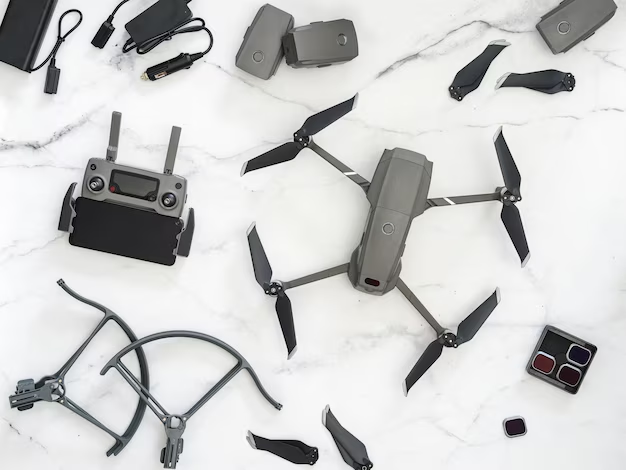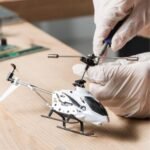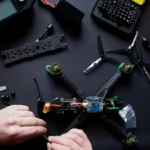
A drone camera holds combination of many components. Each part perform a specific function, from capturing high-quality video to stabilizing the footage. To build or upgrade a drone with a camera system, there are many key components involved. In this article you can understand and learn about all drone parts and their functions, specifications, pros and cons, and where to buy it.
1. Drone Part: Camera Module (Main Camera)
The camera module is the core part of a drone’s camera system. It captures the video footage and sends it to the video transmitter (VTX).
1A. Run Cam Split 4K
- Specifications:
- Resolution: 4K at 30fps, 1080p at 60fps
- Sensor: CMOS
- Field of View (FOV): 155°
- Weight: 19.8g
- Size: 3×3 cm
- Pros:
- Affordable 4K resolution with good image quality.
- Compact design for easy integration into drones.
- Cons:
- Limited frame rate at 4K (30fps).
- Struggles with low-light environments.
- Where to Buy:
- RunCam Official Store – $59.99
- Amazon – $59.99
1B. Foxeer Box 2
- Specifications:
- Resolution: 4K at 60fps
- Sensor: CMOS
- Field of View (FOV): 150°
- Weight: 51g
- Size: 4×4 cm
- Pros:
- Higher frame rate (60fps) for smoother footage.
- Good low-light performance and EIS (Electronic Image Stabilization).
- Cons:
- Heavier than other mini cameras, affecting flight time.
- Expensive compared to some alternatives.
- Where to Buy:
- Foxeer Official Store – $99.99
- Amazon – $99.99
2. Drone Part: Camera Lens
The camera lens determines the angle and quality of the captured footage. Different lenses offer various FOV and image characteristics.
2A. Run Cam Eagle 2 Pro Lens
- Specifications:
- Lens Type: 2.1mm or 2.5mm
- Field of View (FOV): 160°
- Weight: 10g
- Pros:
- Wide FOV perfect for cinematic footage.
- Durable and shock-resistant for drones.
- Cons:
- Not great for low-light conditions.
- Limited to RunCam cameras.
- Where to Buy:
- RunCam Official Store – $19.99
- Amazon – $19.99
2B. Foxeer Micro Lens
- Specifications:
- Lens Type: 1.8mm
- Field of View (FOV): 140°
- Weight: 4g
- Pros:
- Ideal for mini drones and FPV racing.
- Sharp image with good contrast.
- Cons:
- Limited FOV compared to wide-angle lenses.
- Distortion may occur at extreme angles.
- Where to Buy:
- Foxeer Official Store – $15.99
- Amazon – $15.99
3. Drone Part: Gimbal (Camera Stabilization)
A gimbal helps to stabilize the camera and protect shaky footage. It provides smooth video even in windy conditions or when the drone is in motion.
3A. ZOHD S400 Gimbal
- Specifications:
- Weight: 60g
- Dimensions: 5x5x2.5 cm
- Type: 2-axis stabilization
- Camera Capacity: Up to 400g
- Pros:
- Affordable and easy to mount on mini drones.
- Smooth stabilization even in rough conditions.
- Cons:
- Only a 2-axis gimbal, not as smooth as 3-axis gimbals.
- Limited camera weight capacity.
- Where to Buy:
- ZOHD Official Store – $39.99
- Amazon – $39.99
3B. T-Motor Mini Gimbal
- Specifications:
- Weight: 55g
- Dimensions: 6x6x3 cm
- Type: 3-axis stabilization
- Camera Compatibility: Small action cameras like GoPro or FPV cameras
- Pros:
- High-quality 3-axis stabilization for smooth footage.
- Works well with lightweight action cameras.
- Cons:
- Expensive compared to 2-axis gimbals.
- Requires a specific mount depending on drone model.
- Where to Buy:
- T-Motor Official Store – $129.99
- Amazon – $129.99
4. Drone Part: Video Transmitter (VTX)
The VTX sends the live video feed from the camera to the ground station (FPV goggles or monitor). The power of the VTX determines the range.
4A. TBS Unify Pro32 HV
- Specifications:
- Output Power: 25mW, 200mW, 400mW, 800mW
- Weight: 10g
- Voltage Range: 7-36V
- Latency: 28ms
- Pros:
- High power output for long-range FPV.
- Low latency (28ms) ideal for real-time control.
- Cons:
- Expensive compared to simpler VTX options.
- Requires cooling at higher power outputs.
- Where to Buy:
- TBS Official Store – $49.99
- Amazon – $49.99
4B. Foxeer VTX
- Specifications:
- Output Power: 25mW, 200mW, 600mW
- Weight: 7g
- Latency: 20ms
- Channels: 40 channels with Raceband
- Pros:
- Affordable and lightweight.
- Good for short-range FPV with multiple channel options.
- Cons:
- Limited output power at 600mW.
- Not as high-end as other VTXs for long-range use.
- Where to Buy:
- Foxeer Official Store – $27.99
- Amazon – $27.99
5. Drone Part: FPV Goggles (For Viewing the Camera Feed)
FPV goggles allow the pilot to view the live camera feed from the drone, giving them a first-person perspective.
5A. DJI FPV Goggles V2
- Specifications:
- Resolution: 1440x1080p per eye
- Field of View (FOV): 142°
- Latency: 28ms
- Pros:
- Excellent video quality with low latency.
- Wide FOV for immersive FPV experience.
- Cons:
- Expensive.
- Limited compatibility with non-DJI systems without additional adapters.
- Where to Buy:
- DJI Official Store – $649.00
- Amazon – $649.00
5B. Fat Shark HDO2 FPV Goggles
- Specifications:
- Resolution: 1280x960p per eye
- Field of View (FOV): 46°
- Latency: 20ms
- Pros:
- Sharp image quality with a low-latency experience.
- Comfortable fit for extended flying sessions.
- Cons:
- More expensive than other FPV goggles.
- Smaller FOV compared to DJI goggles.
- Where to Buy:
- Fat Shark Official Store – $449.00
- Amazon – $449.00
6. Drone Part: Camera Mounting & Support Parts
- Specifications:
- Material: Carbon fiber or plastic
- Weight: Varies based on design
- Pros:
- Durable and lightweight.
- Allows for secure mounting of cameras and gimbals.
- Cons:
- Some mounts might restrict camera mobility or add extra weight.
- Where to Buy:
6. Drone Part: Drone Frame or Chassis
- Purpose: The frame is the backbone of the drone. It is used to supporting all components like the motors, flight controller, and camera.
- Key Specifications:
- Material: Carbon fiber, plastic.
- Size: It is based on drone type. Like mini drones use smaller frames, while larger drones use bigger frames.
- Weight Capacity: Important to consider, especially if you’re mounting heavy cameras or other accessories.
- Reason to Buy: Lightweight, strong, and durable material like carbon fiber provides excellent performance.
- Reason to Avoid: Plastic frames are weaker and can break easily under impact.
- Where to Buy:
- How to Operate: Frame doesn’t require operation but needs to be correctly assembled, ensuring the motors and other parts are securely mounted.
7. Drone Part: Drone Arms
- Purpose: Extensions that house the motors and connect to the drone’s frame, allowing for stability and maneuverability.
- Key Specifications:
- Length: It is based on the size of the propellers and drone stability.
- Material: It is made with Carbon fiber for strength and lightness.
- Reason to Buy: Carbon fiber arms perform durability without adding too much weight.
- Reason to Avoid: Plastic arms might break more easily. It is reducing the overall life of the drone.
- Where to Buy:
- How to Operate: Arms don’t require operation but should be secured tightly during assembly for balance.
8. Drone Part: Motors
- Purpose: Provide the necessary power to rotate the propellers and generate thrust for flight.
- Key Specifications:
- KV Rating: Higher KV means faster motors. It is useful for racing drones.
- Brushless vs. Brushed: These are more efficient, durable, and provide more power.
- Motor Size: Larger motors can handle bigger drones or heavier payloads.
- Reason to Buy: Brushless motors are reliable. It require less maintenance, and last longer.
- Reason to Avoid: Brushed motors wear out faster and are less efficient.
- Where to Buy:
- How to Operate: Motors are controlled via the flight controller. Regularly check for wear and replace them when needed.
9. Drone Part: Propellers
- Purpose: Propellers are responsible for generating lift, controlling movement, and enabling flight.
- Key Specifications:
- Size: Larger propellers provide more lift and stability.
- Material: Carbon fiber for strength, plastic for affordability.
- Pitch: Higher pitch gives more thrust but can reduce efficiency.
- Reason to Buy: Carbon fiber props are more durable and efficient, especially for racing.
- Reason to Avoid: Plastic props are cheaper but less durable and prone to cracking.
- Where to Buy:
- Amazon – Different sizes and materials.
- RaceDayQuads – For high-performance propellers.
- How to Operate: Propellers need to be attached securely to motors and balanced for stable flight. Always check for damage after each flight.
10. Drone Part: Battery
- Purpose: Provides the necessary power to the drone’s motors and electronics.
- Key Specifications:
- Type: LiPo (Lithium Polymer) for higher power and lightweight, Li-ion for longer flight time.
- Voltage: Usually between 3.7V to 22.2V.
- Capacity: Ranges from 1500mAh for small drones to 5000mAh or more for larger ones.
- C Rating: Determines the maximum discharge rate.
- Reason to Buy: LiPo batteries are efficient and lightweight, providing good power output for drones.
- Reason to Avoid: Li-ion batteries are heavier but offer longer flight times.
- Where to Buy:
- How to Operate: Fully charge before use, avoid overcharging or over-discharging to extend battery life. Always balance charge when possible.
11. Drone Part: Flight Controller Board
- Purpose: The central processing unit that stabilizes the drone and responds to pilot commands.
- Key Specifications:
- Sensors: Gyroscopes, accelerometers, and barometers are integrated.
- GPS Support: Some flight controllers offer built-in GPS for autonomous flying.
- Reason to Buy: A good flight controller ensures stable flight and more control over the drone.
- Reason to Avoid: Low-quality controllers may lead to instability or poor performance.
- Where to Buy:
- RaceDayQuads – Popular for FPV flight controllers.
- HobbyKing – Affordable flight controllers for DIY drones.
- How to Operate: The flight controller is typically configured using software like Beta flight or INAV, which can be connected via USB to tune settings.
12. Drone Part: Sensors
- Purpose: Sensors detect environmental factors and help stabilize the drone.
- Key Types:
- Accelerometer: Measures movement and tilt.
- Gyroscope: Measures rotational speed and orientation.
- GPS: Enables autonomous navigation.
- Obstacle Avoidance Sensors: Ultrasonic or infrared sensors for detecting obstacles.
- Reason to Buy: Sensors improve stability and autonomous capabilities.
- Reason to Avoid: Not all sensors are necessary for basic flights, and they add weight and cost.
- Where to Buy:
- How to Operate: Sensors are integrated into the flight controller or as separate modules, which need to be calibrated for best performance.
13. Drone Part: Camera
- Purpose: Captures video and images for FPV (First-Person View) or aerial photography.
- Key Specifications:
- Resolution: Typically 1080p or 4K for high-definition video.
- Frame Rate: 30fps for standard, 60fps or more for smoother video.
- Lens FOV: Wide-angle lenses (120° to 170°) provide a broader view.
- Reason to Buy: A good camera is essential for high-quality aerial footage or FPV flying.
- Reason to Avoid: Low-quality cameras will result in grainy footage and poor image quality.
- Where to Buy:
- How to Operate: Cameras are generally controlled via the drone’s remote or through an app for live streaming or capturing photos/videos.
14. Drone Part: Variable Speed Drives or Speed Controllers (ESC)
- Purpose: Regulates the speed of each motor based on commands from the flight controller.
- Key Specifications:
- Current Rating: Must match the motor’s power requirements.
- Input Voltage: Compatible with the drone’s battery voltage.
- Reason to Buy: High-quality ESCs offer smoother motor control and better overall flight performance.
- Reason to Avoid: Cheap ESCs may cause instability or motor stuttering.
- Where to Buy:
- How to Operate: ESCs are connected to the motors and configured in the flight controller software.
15. Drone Part: Drone Control Station
- Purpose: Allows the operator to control the drone’s flight via a remote controller.
- Key Specifications:
- Range: Can vary from 1 km to 10+ km.
- Channels: More channels offer better control for additional features (camera, gimbal).
- Reason to Buy: A reliable control station offers precise control over your drone.
- Reason to Avoid: Poor range or low-quality transmitter’s result in unresponsive controls.
- Where to Buy:
- How to Operate: The remote controller sends signals to the drone’s flight controller, which interprets and translates them into motor and movement commands.
16. Drone Part: Landing Gear
- Purpose: Protects the drone’s components during takeoff and landing.
- Key Specifications:
- Material: Plastic or rubber for shock absorption.
- Reason to Buy: Ensures the drone’s camera and other components are protected from damage during landings.
- Reason to Avoid: Heavy landing gear can add unnecessary weight to the drone.
- Where to Buy:
- How to Operate: Landing gear does not require operation, but it should be securely attached before flight.
17. Add-ons
- Purpose: Additional features that can enhance the drone’s functionality, such as extra cameras, lights, or thermal sensors.
- Key Add-ons:
- LED Lights: For visibility during night flights.
- Thermal Cameras: For search and rescue or agricultural work.
- Additional Payloads: For carrying cameras or other sensors.
- Where to Buy:
- How to Operate: Add-ons typically require software configuration and may need additional weight consideration for flight.
These components together form a functional drone. Proper assembly, maintenance, and calibration ensure smooth operation. Each part should be selected based on your intended use (e.g., racing, photography, or general flight).


